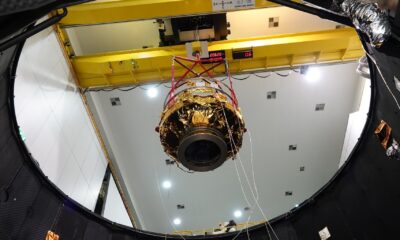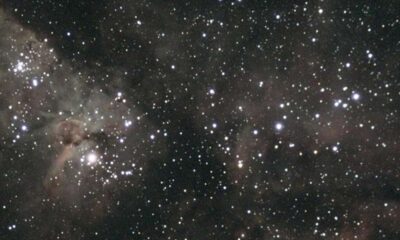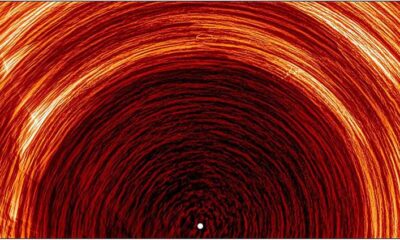Science
Astronomers Detect Brightest Fast Radio Burst Ever from Nearby Galaxy

Astronomers have made a groundbreaking discovery by detecting the brightest fast radio burst (FRB) ever recorded, identified as FRB 20250316A, originating from a nearby galaxy. This flash, observed in March 2023 using the Canadian Hydrogen Intensity Mapping Experiment (CHIME) in British Columbia, emitted more energy in just a few milliseconds than the Sun generates in four days. This significant finding marks a major advancement in understanding these enigmatic cosmic phenomena.
For nearly two decades, scientists have detected FRBs—intense flashes of radio waves—without being able to pinpoint their origins. The recent detection of FRB 20250316A, also referred to as “RBFLOAT” for “Radio Brightest Flash Of All Time,” has changed that narrative. Researchers have long theorized that FRBs result from violent cosmic events, such as collisions between neutron stars. However, due to their fleeting nature, locating their exact source has proven challenging.
Bryan Gaensler, a co-author of the study and dean of the UC Santa Cruz Science Division, expressed the significance of this breakthrough. He likened previous observations to conversing on the phone without knowing the caller’s location. “Now we know not only their exact address, but which room of their house they’re standing in while they’re on the call,” Gaensler stated.
From Detection to Location
The exceptional brightness of RBFLOAT and its proximity to Earth provide vital clues about its origin. The burst was traced to a region approximately 45 light-years across, located on the outskirts of a galaxy roughly 130 million light-years away. This region is part of a spiral arm rich in star-forming areas, although the burst itself originated near, not within, these regions.
Wen-fai Fong, a senior author on the study and professor of physics and astronomy at Northwestern University, emphasized the significance of the CHIME’s newly operational outriggers, which extend across North America from British Columbia to West Virginia. “It is remarkable that only a couple of months after the full Outrigger array went online, we discovered an extremely bright FRB in a galaxy in our own cosmic neighborhood,” Fong noted.
Unlike many FRBs that emit multiple bursts over time, RBFLOAT released all its energy in a single flash. Following its initial detection, no additional bursts were observed from the same source in the subsequent hours.
Exploring the Cosmic Mystery
To further investigate RBFLOAT’s surroundings, researchers utilized data from the Keck Cosmic Web Imager, an advanced instrument on the 10-meter Keck II Telescope in Hawaii. This analysis allowed the team to explore the physical properties of the gas surrounding the FRB, including the star formation rate and gas density in the area.
While the exact cause of the burst remains uncertain, researchers suspect that it may have been produced by a magnetar, a highly magnetized neutron star formed after a supernova explosion. Yuxin “Vic” Dong, a graduate student at Northwestern and co-author of the study, remarked on the intriguing location of the burst. “This could suggest that the progenitor magnetar was kicked from its birth site or that it was born right at the FRB site and away from the clump’s center,” Dong explained.
The successful detection of RBFLOAT represents a significant leap forward in the study of FRBs. Amanda Cook, a postdoctoral researcher at McGill University, described the importance of this advancement: “This result marks a turning point. Instead of just detecting these mysterious flashes, we can now see exactly where they are coming from.”
As the CHIME Outriggers continue to operate, astronomers anticipate identifying more FRBs in the coming years. This growing body of data may ultimately help unravel the mysteries surrounding these cosmic phenomena, shedding light on whether they are caused by dying stars, exotic magnetic objects, or something entirely unknown.
-

 Technology5 months ago
Technology5 months agoDiscover the Top 10 Calorie Counting Apps of 2025
-

 Health2 months ago
Health2 months agoBella Hadid Shares Health Update After Treatment for Lyme Disease
-

 Health3 months ago
Health3 months agoErin Bates Shares Recovery Update Following Sepsis Complications
-

 Technology4 months ago
Technology4 months agoDiscover How to Reverse Image Search Using ChatGPT Effortlessly
-

 Technology1 month ago
Technology1 month agoDiscover 2025’s Top GPUs for Exceptional 4K Gaming Performance
-

 Technology2 months ago
Technology2 months agoElectric Moto Influencer Surronster Arrested in Tijuana
-

 Technology5 months ago
Technology5 months agoMeta Initiates $60B AI Data Center Expansion, Starting in Ohio
-

 Technology5 months ago
Technology5 months agoRecovering a Suspended TikTok Account: A Step-by-Step Guide
-

 Health4 months ago
Health4 months agoTested: Rab Firewall Mountain Jacket Survives Harsh Conditions
-

 Lifestyle5 months ago
Lifestyle5 months agoBelton Family Reunites After Daughter Survives Hill Country Floods
-

 Technology4 months ago
Technology4 months agoHarmonic Launches AI Chatbot App to Transform Mathematical Reasoning
-

 Technology3 months ago
Technology3 months agoUncovering the Top Five Most Challenging Motorcycles to Ride





















